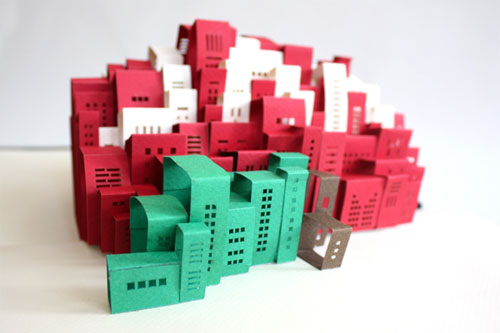When passers-by come across the site of a No Longer Empty exhibition, the term “pop-up” is a frequently uttered categorization of what they see before them. This is half true and half false, for the organization operates in a place somewhere between transient pop-up and permanent cultural space.
In many respects, the exhibition’s temporal residence in an empty piece of real estate has the visual form of a pop-up. As captured in the name, a conventional pop-up seemingly appears from nowhere and too disappears with according nonchalance. However, in the case of No Longer Empty, the exhibition on display is just the tip of the iceberg and can belie the underlying structure that is the foundation for what the public ultimately experiences.
How is No Longer Empty different than a pop-up?
1. In No Longer Empty’s public arts paradigm, there is nothing casual about the art on view and its relationship to the surrounding urban environment. The seed of the exhibition is firmly rooted in the specificity of site, which informs both thematic content as well as the form of community programming. Whereas pop-ups find a context to fit existing art or product, No Longer Empty curates the art to reflect the context.
2. Goals for the neighborhood and meaningful community engagement are ambitious. The nomadic nature of the organization – the fact that it does not operate from a stationary nexus – opens up possibilities for bringing art into different communities and widening the audience for contemporary art. No Longer Empty often provides arts and cultural programming in communities where cuts in budgets have eliminated such programs in schools or for the general public.
3. The exhibitions act as urban interventions that activate community building and partnerships between different community stakeholders. The potential for public art to exercise an impact beyond the exhibition doors and have a revitalizing effect on the streetscape and neighborhood as a whole is pursued by bringing together diverse community leaders who recognize the interim possibilities for its underutilized real estate.
Therefore, a distinguishing mark of No Longer Empty, and arguably the most important from an urban planning perspective, is the lengths taken to leave a legacy – modest, yet meaningful and direct. Its cultural paradigm presents a sustainable structure for community revitalization, capable of being replicated in the local community by the community after the organization’s departure.
In this sense, No Longer Empty’s scope extends beyond the exhibition space itself to the creation of an infrastructure for cultural and economic revitalization of a community via the arts. An illustrative example is the Art in Empty Spaces program that No Longer Empty launched in collaboration with Community Board 3 in Spring 2011. The partnership with CB3, the most local form of government in the Lower East Side, enabled a neighborhood-wide orchestration of six concurrent exhibitions that temporarily transformed vacant storefronts and underutilized spaces.
Earlier this month, No Longer Empty was invited to give testimony about Art in Empty Spaces at the City Council meeting. The topic: The Impact of “Pop-Up Art Installations” in Vacant Store Fronts and Beyond. The interest of City Council in the pop-up phenomenon demonstrates its rising ubiquity in the urban experience.
What the popularity of pop-ups can demonstrate to urban planners and those who are vested in long-term community change is that there is something exciting and impactful about temporal solutions. The impermanent, unexpected nature of a pop-up has an awakening effect, encouraging people to give new attention to their urban environment and re-evaluate what they have come to expect from their neighborhood. This is particularly relevant for long-time residents (less so first-time or occasional visitors) who are the ones most affected by local issues of quality life and community livability. Urban interventions can thereby be short-term and, thanks to that very characteristic, be an empowering tool for future improvements.
Nevertheless, there are important limitations to recognize in the conventional pop-up phenomenon, one of the most important being accountability. It is generally difficult for the community to expect or demand a great deal of the producers/organizers standing in as temporary residents in terms of their commitment to the larger community. Often there is no pretense to engage with community development apart from filling a real estate niche.
In the context of No Longer Empty and like-minded organizations with earnest desire to enact positive urban change, the concept of the pop-up is coupled with a more permanent infrastructure for its implementation. This enables the organization to learn and grow in efficacy so that each intervention is not popping-up anew, out of thin air, but is informed by previous experience and best practices.
The recognition of this logic and structure underlying transient interventions is crucial on the city policy level, where City Council and the Department of Cultural Affairs can establish a legal framework that facilitates rather than hinders creative collaborations between property owners and artists. Periods of transition and real estate vacancies can then expand beyond simple pop-up market opportunities to being opportunities to bridge what a neighborhood is and what it can become.
By Patra Jongjitirat, patra@nolongerempty.org



